Intel’s Iris Xe Max GPU brings graphics chops to thin-and-light laptops - cooperlaisslange
Intel claimed Sat that its new Iris Xe Scoop graphics can exceed Nvidia's GeForce MX350 in gaming, and smooth elevation a GeForce RTX 2080 in some encoding tasks. How it does that—through business leader sharing, and an Intel technology called Deep Radio link—could make the package of an 11th-gen Core Panthera tigris Lake CPU and an Iris Xe Max GPU a spec to look for in future laptops.
Encrypt-named DG1, Intel's first distinct GPU since 1998's Intel i740 will come along in mainstream thin-and-light PCs like the Acer Blue-belly 3x, Asus VivoBook Flip TP470, and Dingle Inspiron 15 7000 2-in-1. The Iris Xe Grievous bodily harm faces off against Nvidia's GeForce MX350 and MX450, both discrete mobile GPUs that split the difference betwixt a play-category mobile GPU and the integrated nontextual matter included in mobile Ryzen and Core processors.
Intel's targeting the Sword lily Xe Max at what information technology calls "flying creators," and it's not hard to see why: The company's information showed the Panthera tigris Lake-Iris Xenon LP combo slightly topping an Ice Lake-GeForce MX350 notebook, though the advantages are slight. Frame in rates don't rattling climb above 45 frames per second, either. In encoding tasks the crack is more profound: 20 percent to 40 percent, and vastly more in some cases.
Intel's technical foul scheme raises its ain interesting prospects for future laptops. The fellowship's pairing of a CPU and distinct GPU began with the impermanent Kaby Lake-G, and the company says it has adapted what it learned there into the Iris Xe Max. The Iris Xe Max takes the merged graphics already built into Tiger Lake, separates IT out into a discrete component, and lets the two act upon conjointly, facilitated by Deep Join. It's almost like cardinal of the same GPUs working together in concert…but not quite.
How prestissimo is Intel's Iris Xe Max artwork?
Darren McPhee, director of separate graphics marketing at Intel, calls the Xe-LP GPU inside of Tiger Lake and the Iris Xe Scoop, "fraternal twins," in terms of the IP and the specs that they apportion. The Iris diaphragm Xe Max provides a faster time speed, plus an odd choice of remembering: LPDDR4x.
Offse, the Numbers. Intel's freehanded Tiger Lake merchandise matrix listed the nontextual matter frequency, which we've highlighted in the graphic beneath. The Iris Xe Grievous bodily harm GPU is a variation of the Panthera tigris Lake-LP GPU, simply running at a faster 1.65GHz. There are 96 EUs deep down the Iris Xe Max, too. The similarities between the Tiger Lake GPU carry over to the memory: Instead of the GDDR memory you might wait, the Sword lily Xe Max addresses just 4GB of LPDDR4x memory, the comparable memory type as Panthera tigris Lake.
 Intel
Intel Piece the Intel Iris Xe Max gets to its high frequencies using different libraries than Panthera tigris Lake, "in that location are a lot of similarities to Tiger Lake," according to Josh Moss, a member of the graphics product marketing team for Intel's Client Computing Grouping.
Here are the full commercial specifications for the Iris diaphragm Xe Liquid ecstasy. Take down that it shares other common features with the Tiger Lake home: PCI Express 4.0, for indefinite, as well as the ability to connect to up to four displays, with up to 8K digest over DisplayPort.
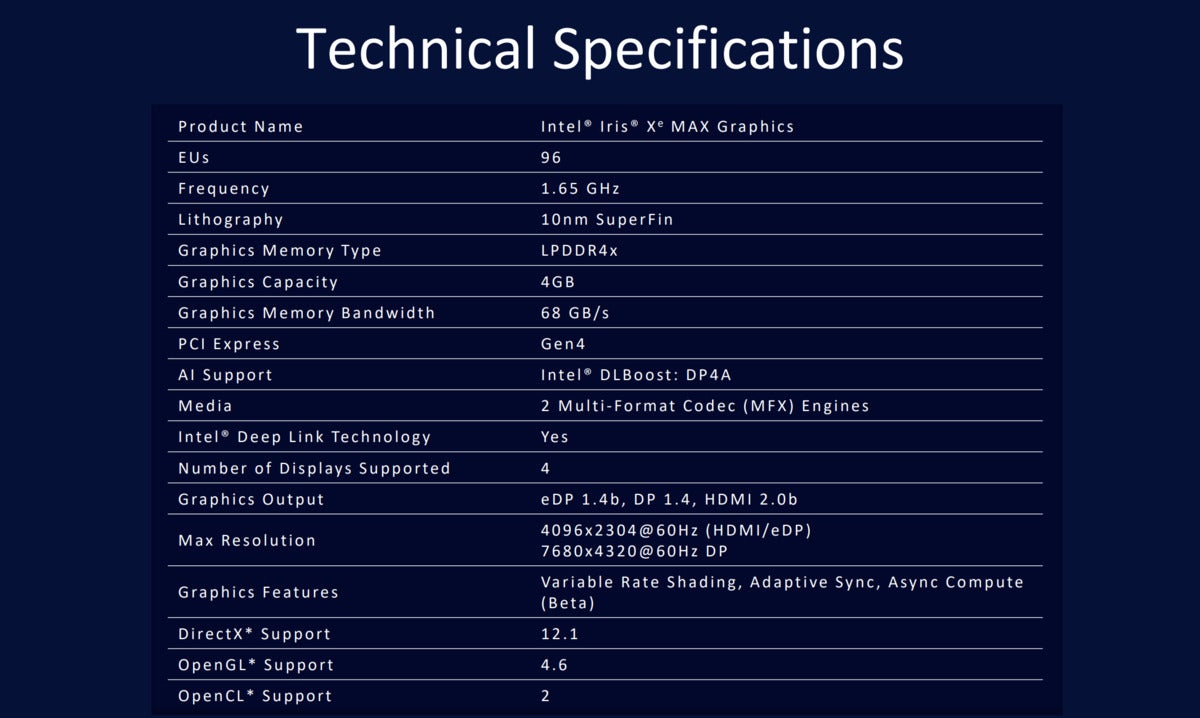 Intel
Intel Intel also promulgated some of its early, unconfirmed data about well the Sword lily Xe Max will compete with Nvidia's GeForce Maxwell serial in gambling.
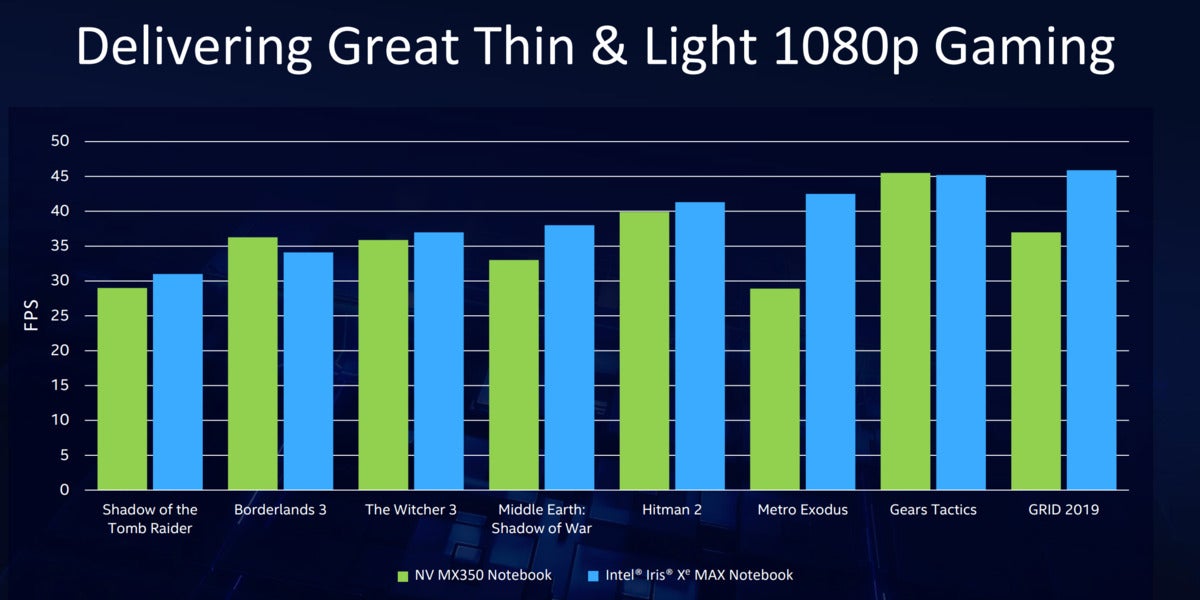 Intel
Intel Intel Iris Atomic number 54 Goop (Acer Gustavus Franklin Swift 3x with Core i7-1165G7/Iris Atomic number 54 Max) is the dispirited bar above, vs. Nvidia's GeForce MX350 (moving alongside a Burden i7-1065G7), the green banish above.
Intel confirmed that, beginning in 2021, IT will begin shipping DG2, the code name for the "Xe HPG" product designed for gaming PCs. There's an unexpected gain: Intel said Saturday that it will be delivery the less powerful Xe LP art found within Tiger Lake to treasure desktop PCs in the first half of 2021, as a discrete graphics solution.
The message behind the Fleur-de-lis Xe Max is simple: Buy in a notebook computer with an Intel Tiger Lake CPU and a discrete Fleur-de-lis Xe Liquid ecstasy GPU chip, and you'll receive Thomas More than the sum of its parts. Intel takes advantage of these two near very pieces of silicon sitting alongside unitary some other, and ties them together finished a common software theoretical account, Moss said. (Physically, one connects to the other via a x4 PCI Extract 4.0 link, according to a company representative.)
Basic, yet, it took a lesson from the unusual fusion of an AMD GPU and Intel CPU to create the Kaby Lake-G chip. Play laptops can run both the GPU and CPU at entire power. Intel's Dynamic Tuning shuttled power back and forth betwixt the CPU and GPU to maintain an overall thermal budget. Now, it's brought that technique to Iris Xe Max art.
With a noesis of what workload is organism run, what's on at the system and OS level off, with temperatures and thermal headroom, "we can make decisions about how a great deal power to give to each," Moss said. The driver software adjusts the power levels (PLs) on each like a sho, based on thermal measurements, utilization, and more than. "And then if it's a CPU-centric workload and the GPU's not running, we can bias the power over to the CPU, and for a GPU, we rump obviously bias the superpowe finished to the GPU."
 Intel
Intel Intel provided its own estimates for how power sharing would gain general performance.
We've seen this before with Intel's competitors, specifically the intriguing SmartShift technology that AMD debuted earlier this year. Regrettably, traditionalist planning away PC makers confined the technology to a single Dingle notebook, the Dell G5 15 SE.
Intel's Artful Tie-in deeds in a corresponding manner. Hither, Intel's software framework is aware that on that point's an Iris Xe Max aboard the Tiger Lake CPU. IT leverages the combined AI (VNNI and DP4a) and the multiple media encoders on each small-arm of silicon to put them wholly to work at the same time.
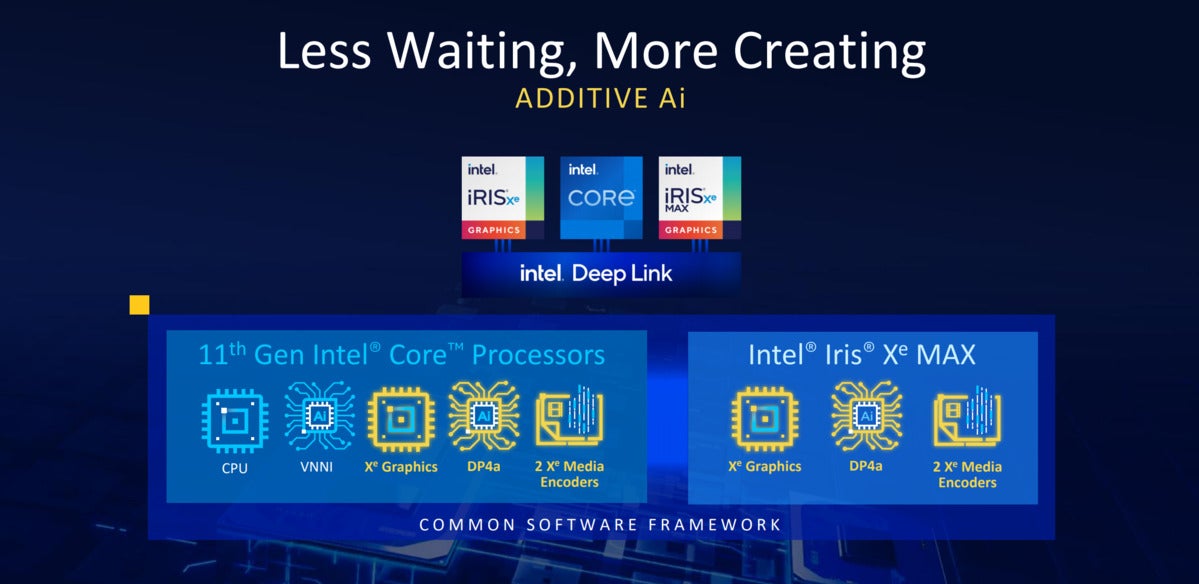 Intel
Intel Intel's Tiger Lake and its Iris Xenon Max GPUs have communal functions that can work together via Deep Link.
This can make for out in several ways. In one and only demonstration, for case, Intel in use the Topaz Labs' Gigapixel upscaler algorithm to add contingent to a 1.4MP image, upscaling it to the tantamount of 23MP. Intel pitted a 10th-gen Ice Lake/GeForce MX350 notebook using TensorFlow vs.a Tiger Lake/Iris Atomic number 54 Max system and found that its organisation finished seven times faster, upscaling multiple photos. (Intel executives said they didn't have a GeForce MX450 system to test.) In a second test, Intel compared a Core i9-10980K system with a RTX2080 GPU with a Kernel i7-1165G7 and Sword lily Xe Max graphics in transcoding 10 one-narrow clips from 4K/60 AVC to 1080p/60 HEVC victimisation Handbrake. Intel finished 1.78 multiplication faster.
Intel laid dead a list of applications that can take vantage of this behavior: HandBrake, Open Broadcaster Software (OBS), False topaz Gigapixel AI, xSplit, Huya, Joyy, Leela Chess game 0 (Lc0), and Xiaohulu. Blender, CyberLink, Fluendo, and Magix Software will arrive soon, Moss said.
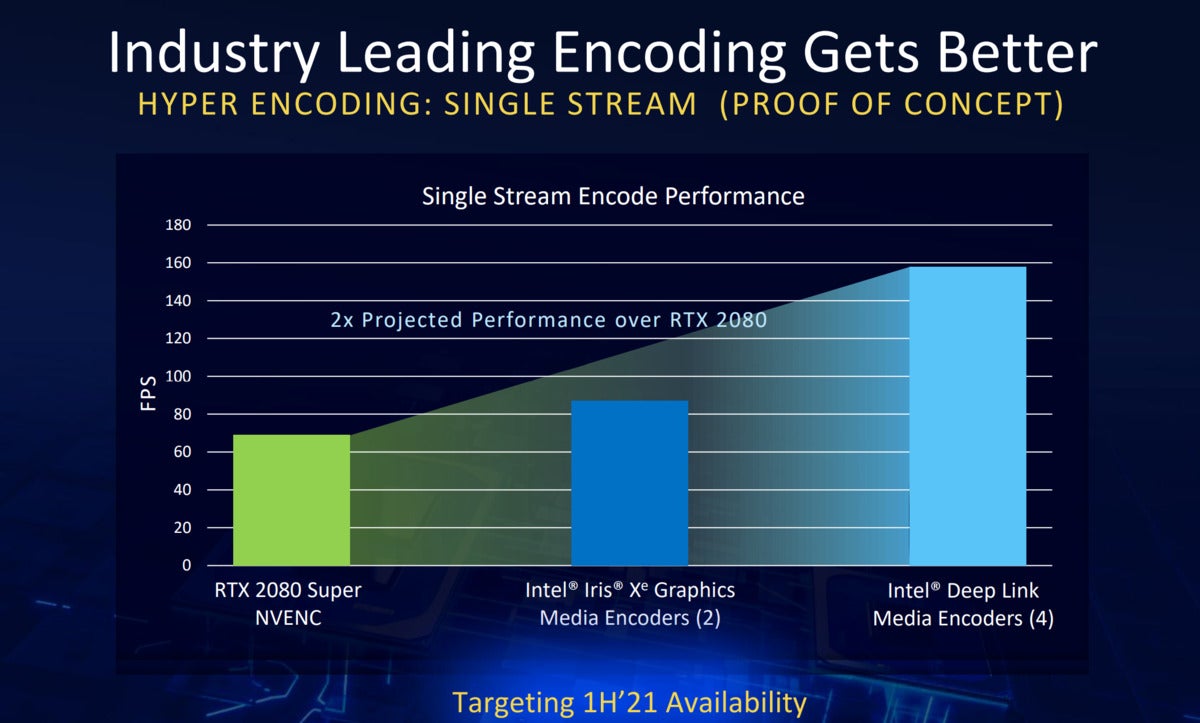 Intel
Intel Moss also said that Intel hopes to ship a proof of concept during the first half of 2021 for single-pullulate encoding. That will depend on finalizing the implementation, and then sending IT to FFMPEG, the locomotive that HandBrake runs, according to an Intel representative.
Same interesting disclosure that Intel made was admitting that there will be roughly applications and games that do not run better happening a occluded Tiger Lake/Iris Xe Easy lay system, and will realize augmented frame rates on the Tiger Lake processor with its own tight-knit GPU. (A large part of this involves the latencies of expiration backward and forward between the two GPUs.) In this case, Moss said, the system is smart enough to confine the art workload to whichever GPU is the most appropriate.
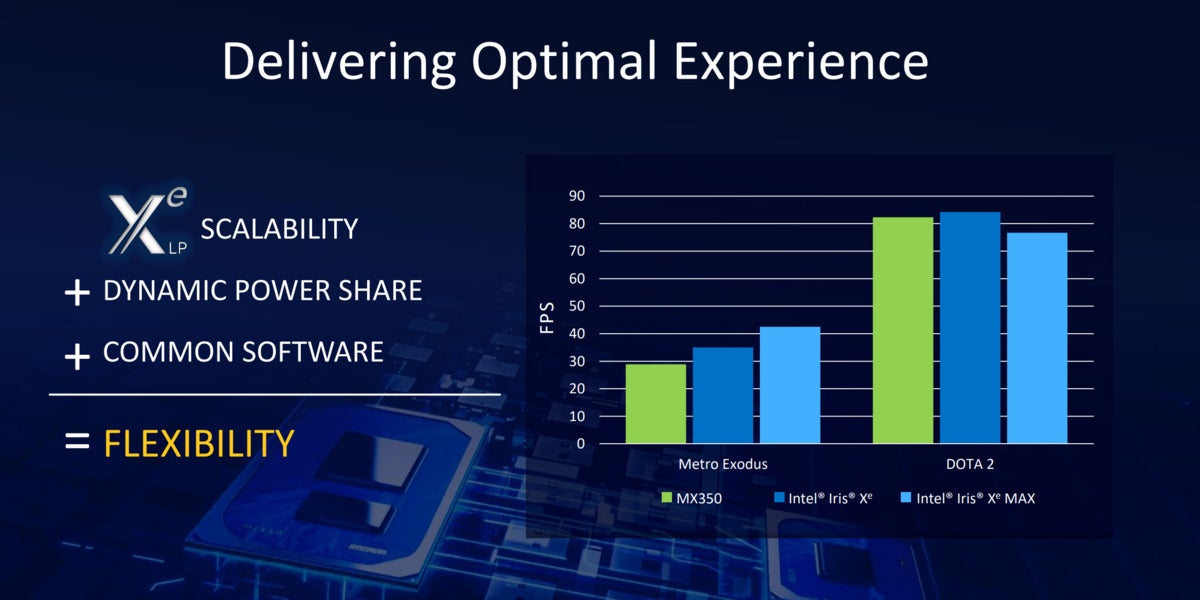 Intel
Intel In cases where Intel's Heavy Connect-connected GPUs won't benefit gamers, Intel says that its drivers will be smart decent to adjust.
Settled on Intel's current improvements, you power call up that all this is a employment in progress. Intel seems to feel that way, likewise. McPhee called the Flag Xe Goop a "very strategically created part" that allows Intel to acquire the internal software that will allow Intel to enter the separate graphics market—non with the Iris Xe Soap (DG1), but the DG2. It seems very probable that Intel will be selling its upcoming Xe-HPG part as a package deal, taking advantage of the combining of the CPU and GPU to inflate its performance numbers relative to the competition. How will it all play out? We have about a year to find out.
Source: https://www.pcworld.com/article/393686/intels-iris-xe-max-gpu-brings-graphics-chops-to-thin-and-light-laptops.html
Posted by: cooperlaisslange.blogspot.com

0 Response to "Intel’s Iris Xe Max GPU brings graphics chops to thin-and-light laptops - cooperlaisslange"
Post a Comment